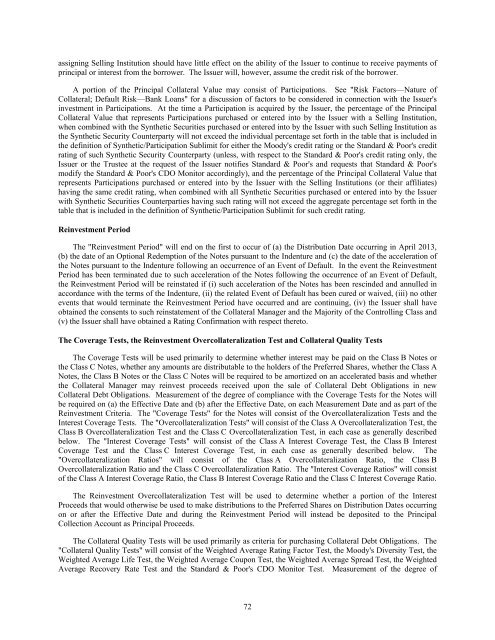Octagon Investment Partners IX, Ltd. JPMorgan - Irish Stock Exchange
Octagon Investment Partners IX, Ltd. JPMorgan - Irish Stock Exchange
Octagon Investment Partners IX, Ltd. JPMorgan - Irish Stock Exchange
Create successful ePaper yourself
Turn your PDF publications into a flip-book with our unique Google optimized e-Paper software.
assigning Selling Institution should have little effect on the ability of the Issuer to continue to receive payments of<br />
principal or interest from the borrower. The Issuer will, however, assume the credit risk of the borrower.<br />
A portion of the Principal Collateral Value may consist of Participations. See "Risk Factors—Nature of<br />
Collateral; Default Risk—Bank Loans" for a discussion of factors to be considered in connection with the Issuer's<br />
investment in Participations. At the time a Participation is acquired by the Issuer, the percentage of the Principal<br />
Collateral Value that represents Participations purchased or entered into by the Issuer with a Selling Institution,<br />
when combined with the Synthetic Securities purchased or entered into by the Issuer with such Selling Institution as<br />
the Synthetic Security Counterparty will not exceed the individual percentage set forth in the table that is included in<br />
the definition of Synthetic/Participation Sublimit for either the Moody's credit rating or the Standard & Poor's credit<br />
rating of such Synthetic Security Counterparty (unless, with respect to the Standard & Poor's credit rating only, the<br />
Issuer or the Trustee at the request of the Issuer notifies Standard & Poor's and requests that Standard & Poor's<br />
modify the Standard & Poor's CDO Monitor accordingly), and the percentage of the Principal Collateral Value that<br />
represents Participations purchased or entered into by the Issuer with the Selling Institutions (or their affiliates)<br />
having the same credit rating, when combined with all Synthetic Securities purchased or entered into by the Issuer<br />
with Synthetic Securities Counterparties having such rating will not exceed the aggregate percentage set forth in the<br />
table that is included in the definition of Synthetic/Participation Sublimit for such credit rating.<br />
Reinvestment Period<br />
The "Reinvestment Period" will end on the first to occur of (a) the Distribution Date occurring in April 2013,<br />
(b) the date of an Optional Redemption of the Notes pursuant to the Indenture and (c) the date of the acceleration of<br />
the Notes pursuant to the Indenture following an occurrence of an Event of Default. In the event the Reinvestment<br />
Period has been terminated due to such acceleration of the Notes following the occurrence of an Event of Default,<br />
the Reinvestment Period will be reinstated if (i) such acceleration of the Notes has been rescinded and annulled in<br />
accordance with the terms of the Indenture, (ii) the related Event of Default has been cured or waived, (iii) no other<br />
events that would terminate the Reinvestment Period have occurred and are continuing, (iv) the Issuer shall have<br />
obtained the consents to such reinstatement of the Collateral Manager and the Majority of the Controlling Class and<br />
(v) the Issuer shall have obtained a Rating Confirmation with respect thereto.<br />
The Coverage Tests, the Reinvestment Overcollateralization Test and Collateral Quality Tests<br />
The Coverage Tests will be used primarily to determine whether interest may be paid on the Class B Notes or<br />
the Class C Notes, whether any amounts are distributable to the holders of the Preferred Shares, whether the Class A<br />
Notes, the Class B Notes or the Class C Notes will be required to be amortized on an accelerated basis and whether<br />
the Collateral Manager may reinvest proceeds received upon the sale of Collateral Debt Obligations in new<br />
Collateral Debt Obligations. Measurement of the degree of compliance with the Coverage Tests for the Notes will<br />
be required on (a) the Effective Date and (b) after the Effective Date, on each Measurement Date and as part of the<br />
Reinvestment Criteria. The "Coverage Tests" for the Notes will consist of the Overcollateralization Tests and the<br />
Interest Coverage Tests. The "Overcollateralization Tests" will consist of the Class A Overcollateralization Test, the<br />
Class B Overcollateralization Test and the Class C Overcollateralization Test, in each case as generally described<br />
below. The "Interest Coverage Tests" will consist of the Class A Interest Coverage Test, the Class B Interest<br />
Coverage Test and the Class C Interest Coverage Test, in each case as generally described below. The<br />
"Overcollateralization Ratios" will consist of the Class A Overcollateralization Ratio, the Class B<br />
Overcollateralization Ratio and the Class C Overcollateralization Ratio. The "Interest Coverage Ratios" will consist<br />
of the Class A Interest Coverage Ratio, the Class B Interest Coverage Ratio and the Class C Interest Coverage Ratio.<br />
The Reinvestment Overcollateralization Test will be used to determine whether a portion of the Interest<br />
Proceeds that would otherwise be used to make distributions to the Preferred Shares on Distribution Dates occurring<br />
on or after the Effective Date and during the Reinvestment Period will instead be deposited to the Principal<br />
Collection Account as Principal Proceeds.<br />
The Collateral Quality Tests will be used primarily as criteria for purchasing Collateral Debt Obligations. The<br />
"Collateral Quality Tests" will consist of the Weighted Average Rating Factor Test, the Moody's Diversity Test, the<br />
Weighted Average Life Test, the Weighted Average Coupon Test, the Weighted Average Spread Test, the Weighted<br />
Average Recovery Rate Test and the Standard & Poor's CDO Monitor Test. Measurement of the degree of<br />
72

















